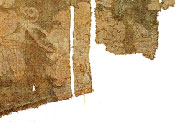 |
 |
||||||||||||||||
 |
|||||||||||||||||
 |
|||||||||||||||||
| Classified Glossary | |||||||||||||||||
 |
|||||||||||||||||
 |
|||||||||||||||||
| 56. 1Wax-resist dyeing Hot wax is applied on the textile either by a patterned stamp or a pointed tool as a resist before dyeing. Wax-resist dyeing (laran or axie, commonly referred to in English as batik) was probably introduced into northwestern China along the Silk Road in 3rd to 5th century and became popular in the Tang dynasty. After that, this method was limited in use to the minority areas of southwestern China. 57. 1Ash-resist and starch-resist dyeing Ash-resist dyeing (huixie) uses ash or other alkaline material mixed with the starch as the resist agent instead of wax, it can get a similar result to wax resist dyeing. It appeared in Tang dynasty and was adapted to cotton cloth. This is the technique known as starch-resist dyeing (banxie) used on the popular blue-and-white clothes (lanyinhuabu). 58. 1Gold powder and foil sticking Sticking gold foil (tiejin) or sticking gold and silver powder (nijinyin or xiaojin) on textiles was frequently mentioned in Tang poems but current excavations show the most popular period for this technique was in the Yuan dynasty. |
|||||||||||||||||
| THE BOOK | |||||||||||||||||
| AUTHOR | |||||||||||||||||
| CONTENTS | |||||||||||||||||
| ORDER | |||||||||||||||||
| CONTACT | |||||||||||||||||
| LINKS | |||||||||||||||||